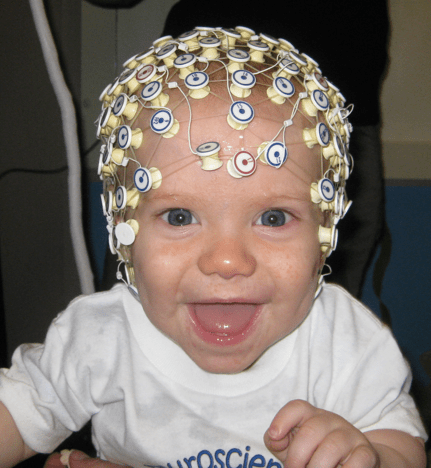Advertisement
How Might Autistic Children Be Similar? In Their Brainwaves

Most people talk about autism’s differences — that no two children on the spectrum are alike. But Dr. Frank H. Duffy at Boston Children’s Hospital thinks he’s found a way that they’re all the same: in their brainwaves.
In a study published today in the journal BMC Medicine, he showed that 460 children with autism had incredibly consistent electrical brain activity across 40 different measures. The patterns of their brainwaves were also distinctively different from 570 children unaffected by the condition, suggesting that such brainwaves could be used to diagnose autism.
“This is a very stable, identifiable group, easily differentiable from normal subjects,” said Duffy, director of developmental neurophysiology at Children’s, and an associate professor of neurology at Harvard Medical School.
Duffy said he hopes his EEG analysis could also be used to show whether an autism treatment is working.
“If you think you have a useful therapy, looking at the physiological brain changes might be a hint that you’re going in the right direction or not,” he said.
And he hopes that future EEG studies will show whether Asperger’s should be folded into the larger diagnosis autism spectrum — as a professional group has suggested — or remain its own condition. Autism is characterized by social and communication problems and repetitive behaviors. Duffy said he suspects that Asperger’s, which is similar to autism but without as many communication challenges, may actually be a separate condition.
In other EEG work at Boston Children’s, Charles Nelson has found that he can distinguish between babies who are at high versus low risk of developing autism. Children with siblings on the spectrum have a 20 percent chance of developing the condition, while children in previously unaffected families have about a 1 percent risk.
In a study published last week in PLoS One, Nelson and his colleagues showed that there were fewer brainwaves in the high-risk children across a range of activities including consciousness, processing and integration of information.
“The high-risk group carries a unique neural signature that makes them look different,” Nelson said this morning.
Nelson said he hopes his investigations will eventually allow doctors to predict which infants are likely to go on to develop autism, and therefore which should get early behavioral intervention, which is the only proven treatment for autism so far.
While Duffy uses EEG to examine correlations among brain areas, Nelson looks at specific types of frequencies over particular parts of the scalp. Both suggest there is something different about the autistic brain, Nelson said.
“There’s something that lives in the EEG that distinguishes whether you are high-or low-risk and whether you do or don’t have autism,” he said.
Next, Nelson said he hopes to explore whether there is a gradation between the brains of people with autism and people without, or some sharp distinction between the two.
Duffy, who is working with Boston Children's neonatologist Heidelise Als, also plans to compare the brainwaves of children with Asperger’s, and examine children with a wider range of conditions related to autism, such as Fragile X and epilepsy; as well as any brainwave differences between boys and girls with autism.
Dr. Fernando Miranda, a cognitive behavioral neurologist in San Francisco, and long-time friend of Duffy’s, said an-EEG-based test will also be much easier for people with autism than other types of brain scans. Children don’t have to lie still for an EEG to work, or be placed into an MRI tube — both of which can be a challenge for a child on the spectrum.
“This is really an important way of looking objectively” at the brain of someone with autism, Miranda said.
Karen Weintraub, a frequent contributor to CommonHealth, is a Cambridge-based health and science journalist.
This program aired on June 26, 2012. The audio for this program is not available.
